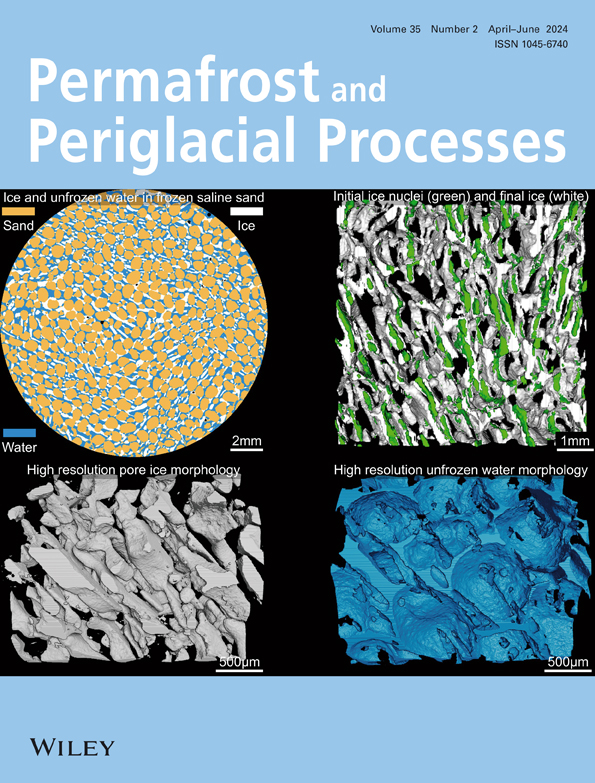InSAR和青藏高原多年冻土地形原位监测探测到的地面冰融化证据
IF 3.3
3区 地球科学
Q2 GEOGRAPHY, PHYSICAL
引用次数: 3
摘要
近年来,富冰永久冻土的融化引起了人们的极大关注。在本研究中,我们分析了通过SBAS‐InSAR技术在青藏高原(QTP)获得的跨越6年的地表变形时间序列,以及长期活动层土壤温度和湿度的原位观测及其关系。通过对地面沉降速度和活动层增厚率以及活动层底部液态水增加的定量分析,结果表明,长期沉降速度直接代表地表冰的融化,而不是活动层的增厚率。尽管活动层加深率可能非常高,但贫冰永久冻土融化不会导致明显的沉降。空间分析表明,山麓和缓坡(1-5度)的长期变形速度较大,与地貌条件密切相关,地貌条件可以调节土壤性质和地面含冰量。这些发现提高了对冻土融化退化的理解,并促进了多年冻土环境中地面冰融化自动绘图的方法发展。本文章由计算机程序翻译,如有差异,请以英文原文为准。
Evidence of ground ice melting detected by InSAR and in situ monitoring over permafrost terrain on the Qinghai‐Xizang (Tibet) Plateau
The thawing of ice‐rich permafrost has attracted considerable attention in recent years. In this study, we analyzed both the ground surface deformation time series spanning 6 years, derived through the SBAS‐InSAR technique on the Qinghai‐Xizang (Tibet) Plateau (QTP), and the long‐term active layer soil temperature and moisture in situ observations and their relationships. The results showed that long‐term subsidence velocity directly represents the melting of ground ice instead of the thickening rate of the active layer by a quantitative analysis of both terrain subsidence velocity and active layer thickening rate and the increase in liquid water at the bottom of the active layer. Ice‐poor permafrost thawing does not result in distinct subsidence, although the active layer deepening rate can be very high. The spatial analysis reveals that long‐term deformation velocities are large in the foothills and on gentle slopes (1–5 degrees) and are closely related to geomorphological conditions, which could regulate the soil properties and ground ice content. These findings improve the understanding of the thawing degradation of icy permafrost and promote method developments for the automated mapping of ground ice melting in permafrost environments.
求助全文
通过发布文献求助,成功后即可免费获取论文全文。
去求助
来源期刊
CiteScore
9.70
自引率
8.00%
发文量
43
审稿时长
>12 weeks
期刊介绍:
Permafrost and Periglacial Processes is an international journal dedicated to the rapid publication of scientific and technical papers concerned with earth surface cryogenic processes, landforms and sediments present in a variety of (Sub) Arctic, Antarctic and High Mountain environments. It provides an efficient vehicle of communication amongst those with an interest in the cold, non-glacial geosciences. The focus is on (1) original research based on geomorphological, hydrological, sedimentological, geotechnical and engineering aspects of these areas and (2) original research carried out upon relict features where the objective has been to reconstruct the nature of the processes and/or palaeoenvironments which gave rise to these features, as opposed to purely stratigraphical considerations. The journal also publishes short communications, reviews, discussions and book reviews. The high scientific standard, interdisciplinary character and worldwide representation of PPP are maintained by regional editorial support and a rigorous refereeing system.

 求助内容:
求助内容: 应助结果提醒方式:
应助结果提醒方式:


